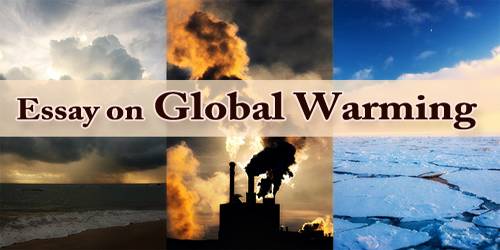Introduction: Global warming refers to the gradual rise in the overall temperature of the atmosphere of the Earth. There are various activities taking place which have been increasing the temperature gradually. Over the past 50 years, the average global temperature has increased at the fastest rate in recorded history. And experts see the trend is accelerating: All but one of the 16 hottest years in NASA’s 134-year record have occurred since 2000. The mean global temperature in the 1960s was 13.9-degree Celsius whereas in 2017 it was 14.9-degree Celsius. Thus, no one can deny the fact that the temperatures have been rising on our planet.
Global warming is melting our ice glaciers rapidly. This is extremely harmful to the earth as well as humans. It is quite challenging to control global warming; however, it is not unmanageable. The first step in solving any problem is identifying the cause of the problem. Therefore, we need to first understand the causes of global warming that will help us proceed further in solving it.
Causes of Global Warming: Global warming occurs when carbon dioxide (CO2) and other air pollutants and greenhouse gases collect in the atmosphere and absorb sunlight and solar radiation that have bounced off the earth’s surface. Normally, this radiation would escape into space but these pollutants, which can last for years to centuries in the atmosphere, trap the heat and cause the planet to get hotter. That’s what’s known as the greenhouse effect.
Ice ages and warmer periods have occurred alternatively and naturally on Earth. Natural warming happens when Earth is closer to the Sun. But, it is the greenhouse gases that lead to a rapid temperature increase and disrupt the natural cycle of changes. The gases such as the oxides of carbon and sulfur are greenhouse gases. These gases, when present in the atmosphere, trap the incoming radiation and heat from the Sun. The phenomenon of atmospheric gases acting as a shield is known as the greenhouse effect. We humans have been primarily responsible for the release of these harmful gases. Our activities such as industrial production, petroleum extraction, transportation, burning fossil fuel, mining, cattle rearing, and deforestation are primarily responsible for global warming.
Methane is one crucial greenhouse gas that needs to be mentioned in this context. It is released from cattle, landfill, natural gas, petroleum extraction, coal mining, mobile explosion, and industrial waste process. Methane is also released during volcanic eruptions. It is said to be twenty times more effective than carbon dioxide in trapping heat.
So, when one of the biggest sources of absorption of carbon dioxide will only disappear, there will be nothing left to regulate the gas. Thus, it will result in global warming. Steps must be taken immediately to stop global warming and make the earth better again.
Impacts of Global Warming: The impacts of global warming are being felt across the globe. Extreme heat waves have caused tens of thousands of deaths around the world in recent years. And in an alarming sign of events to come, Antarctica has been losing about 134 billion metric tons of ice per year since 2002. This rate could speed up if we keep burning fossil fuels at our current pace, some experts say, and causing sea levels to rise several meters over the next 50 to 150 years.
One of the most striking impacts of rising temperatures is felt in global agriculture, although these impacts are felt very differently in the largely temperate developed world and in the more tropical developing world. The productivity of rice, the staple food of more than one-third of the world’s population, declines 10% with every 1⁰ C increase in temperature. At the same time, global population models suggest that developing world will add 3 billion people by 2050 and that developing world food producer must double staple food crop production by then simply to maintain current levels of food consumption.
Consequences of Global Warming: The first impact of global warming is the melting of polar ice caps and glaciers. So, a loss of habitat for species in the frozen zone is likely. Losing tones of ice could result in the rising of sea levels, and inundation of coastal areas all over the world. Glaciers are the sources of our rivers. With no glaciers, many rivers could dry up, leading to severe water scarcity.
Global warming and erratic changes in climate pattern are closely linked. Frequent droughts, more torrential rain falls, stronger cyclones are becoming common in various parts of the world. Extreme heat-waves and wildfires are becoming a regular phenomenon. All these impact not only our economy but also normal human life. Millions have succumbed to nature’s fury and may continue as predicting the climatic conditions is getting complicated.
Global warming impacts food availability too. Many plants cannot withstand severe droughts and floods. Agriculture could become a very costly occupation. New pests and fertilizer resistant insects are evolving as they can tolerate harsher weather. Livestock is at risk from heat stress and poor quality of food supply. As oceans absorb CO2 emissions, they are getting acidified. Our underwater species are getting wiped out at a fast rate.
Solutions of Global Warming: As stated earlier, it might be challenging but it is not entirely impossible. Global warming can be stopped when combined efforts are put in. For that, individuals and governments, both have to take steps towards achieving it. We must begin with the reduction of greenhouse gas.
Furthermore, they need to monitor the consumption of gasoline. Switch to a hybrid car and reduce the release of carbon dioxide. Moreover, citizens can choose public transport or carpool together. Subsequently, recycling must also be encouraged. For instance, when you go shopping, carry your own cloth bag. Another step you can take is to limit the use of electricity which will prevent the release of carbon dioxide. On the government’s part, they must regulate industrial waste and ban them from emitting harmful gases in the air. Deforestation must be stopped immediately and planting of trees must be encouraged.
Now nations across the world have understood the urgency of the global warming issue, and are taking action to prevent further rising of global temperatures. There have been many agreements on ways to reduce the emission of greenhouse gases in the past. The latest one is the Paris agreement by the United Nations Framework Convention on Climate Change (UNFCCC) members. The main goal of this agreement is to keep the increase in global average temperature to well below 2 °C above pre-industrial levels and to limit the increase to 1.5 °C.
Conclusion: In short, all of us must realize the fact that our earth is not well. It needs to treatment and we can help it heal. The present generation must take up the responsibility of stopping global warming in order to prevent the suffering of future generations. Therefore, every little step, no matter how small carries a lot of weight and is quite significant in stopping global warming. As individuals, we too have the responsibility in making our planet a safe abode for our future generations. Instead, it is better to go to beaches, parks, and zoos, so that we realize the importance of preserving nature’s gift to mankind.
















